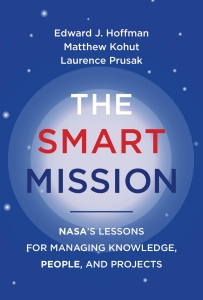Going back to the Apollo program, NASA has been synonymous with incredibly complex space missions. While astronauts like Neil Armstrong and Buzz Aldrin received the glory, no space endeavor would’ve been possible without thousands of people behind the scenes.
Edward J. Hoffman spent 33 years working for NASA, rising to become a senior executive and founder of the NASA Project Leadership Academy. His intriguing new book (co-authored with Matthew Kohut and Laurence Prusak) is The Smart Mission: NASA’s Lessons for Managing Knowledge, People, and Projects, plenty of which can be applied to small businesses.
b.: You write that “successful organizations have a project-based culture.” How can small-business owners adapt their enterprises?
Hoffman: My experience is that small-business owners have a better understanding of project management and team skills than those working in very large institutions. Small-business people need to talk directly with a client throughout [because] they understand the need for delivery within constraints, and normally have an excellent sense of relationship.
b.: What’s a hidden key to effective projects?
Hoffman: There’s a saying, “You go to NASA for the mission, you stay at NASA for the people.” We are brought up to value the power of tools, techniques, and processes. These are all valuable and essential for business success. However, we need to recognize that the human element is the foundation for business success.
There is a sound to successful teams. It is noisy. It involves argument, laughter, conversations, walking and talking … On LinkedIn, my page’s opening statement says, “PEOPLE, PEOPLE, PEOPLE.”
b.: What’s the most critical mistake you see from project managers?
Hoffman: They make the mistake of following requirements without the need for adapting to change. … You observe an adherence to process and structure, but the client is asking for something different.
Also it’s the belief that a new technology will lead to improvement without taking time to … understand what the team and the customer really need.
b.: When organizing a project, where must a small business start?
Hoffman: First, prioritize the mission — for a small business, this could be termed the goal — and gain 110% commitment. At NASA, everything, every project, has a destination. Then communicate the purpose of the mission; I call it the “Why We Are Here” element of the project. And nourish the team.
The Smart Mission is available now.







.png)